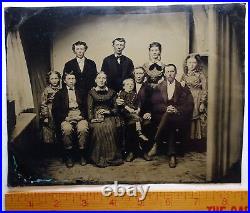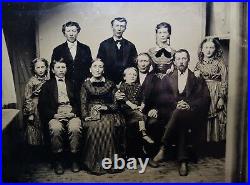




The Well-known Case Family. For offer, a rare and interesting photo! Fresh from a prominent estate in Upstate NY. Never offered on the market until now. Vintage, Old, Original, Antique, NOT a Reproduction – Guaranteed!! One of a kind. Shows many people in the family, with seated older woman holding photo album. “Chase, Auburn, NY” etched on back. Measures 8 1/2 x 6 1/2 inches. In good to very good condition. I few bends, light creases, minor surface scuffs / scratches – normal for these photos. If you collect 19th century Americana history, women / men portrait, American photography, fashion, etc. This is a treasure you will not see again! Add this to your image or paper / ephemera collection. Perhaps genealogy research importance too. Sylvester Willard joined First Presbyterian Church by letter from Second Presbyterian Church in Chicago, where he had practiced medicine before coming to Auburn. Thus begins the story of First Presbyterian Church and the Case Mansion on the church grounds. Willard was a well-regarded physician and also an organizer in 1848 of the Oswego Starch Company. He was very wealthy and equally generous. He was a benefactor of First Presbyterian Church and an elder for 38 years (1848 – 1886). Willard was a great friend of Rev. Charles Hawley, pastor from 1857 to 1885. Willard’s digest of Dr. Hawley’s sermons is a treasure in the church archives. Willard was married to Jane Case Willard, whose brother, Theodore Pettibone Case, was a benefactor of the church also. His son was Willard Erastus Case, whose son was Theodore Willard Case, the builder of the Case Mansion. Willard had two daughters. These generous women donated the Willard Chapel to the Auburn Theological Seminary. They died with no heirs other than their cousin Willard Erastus Case. Thus the Willard fortune came into the hands of Theodore Willard (Ted) Case. Ted Case was very inventive and devised a method of putting sound on film. Thus he is credited with inventing talking pictures. His work was done in a laboratory behind his home, the former Willard Mansion, now the Cayuga Museum. The MacDougall and Boyd mansions were demolished to make way for the new house, which is very large, with 65 rooms. Over time Ted Case’s fortunes waned, and he gave the Willard Mansion to the city in 1936, and the Case Mansion to the city in 1938. From 1938 to 1946 the Case Mansion was used for various purposes including a National Youth Administration center, housing women who lived and worked in the mansion, making sheets, pillowcases, and towels for wartime supply. In 1972 the Carmelites offered shelter to mentally retarded people there. Afterwards, the Fathers invited a group of volunteers to move in and shelter mentally disabled veterans in the mansion. The service came to be called Unity House. By 1975 the Carmelites could no longer afford to keep the Case Mansion property. In the meantime, First Presbyterian Church continued its mission and ministry. In 1869 the church had built a massive limestone edifice and gradually acquired land all around, often improving the land because there was a need. Then, in 1969, the city embarked on plans to build an arterial highway. The church would lose much of its land, be landlocked on the north side, and thus severed from some of its property. On April 5, 1973 the organist arrived early for choir practice and began to play. The giant steeple collapsed on the organ, but the organist was thrown aside and walked out of the church. The search began for a new site. The Carmelite Fathers offered land next to the Case Mansion, and there the new First Presbyterian Church was built in 1975. The Carmelites’ crisis deepened, and the volunteers feared they would lose their home in the Case Mansion, as well as that of the disabled veterans–and the mission of caring for these men. The church did so, thus embarking on yet another enormous mission in a long history of great missions by this small church in a small city. Pastor Dennis Haines worked with the volunteers to incorporate their Unity House program, find an executive director, and secure all the approvals needed to operate mental health services in New York state. The program operated for 35 years in the Case Mansion and has expanded to other locations as well. It has grown from serving 24 disabled veterans to serving more than 700 clients a day in several counties. Members of First Presbyterian Church serve on the Unity House board and other committees. With changes in mental health services, the Unity House residence program left the mansion at the end of 2011. At its stated meeting in December 2016, after prayer and discernment, the session approved plans in re-designing the Case Mansion as our churchs new Presbyterian Event and Retreat Center (PERC). The Center continuing the mission of First Presbyterian Church (Led by God, Serving Christ, Guided by the Holy Spirit, Strong in Faith) is to provide an ecumenical ministry of hospitality, offering programs, space and nourishment to individuals and groups desiring spiritual growth, renewal and peace. In the tradition of Presbyterian retreat centers like Montreat in North Carolina or Stony Point in New York, the Center will offer opportunities to bring people together from all walks of life for prayer, rejuvenation and creative ways in building community. Auburn is a city in Cayuga County, New York, United States, located at the north end of Owasco Lake, one of the Finger Lakes, in Central New York. As of the 2010 census, the city had a population of 27,687. [4] It is the county seat of Cayuga County, [5] and the site of the maximum-security Auburn Correctional Facility, as well as the William H. Seward House Museum and the house of abolitionist Harriet Tubman. Auburn, New York (1909), by William Bruce (18611911). The Auburn Works in 1907. State Street in 1910. The region around Auburn had been Haudenosaunee territory for centuries before European contact and historical records. Auburn was founded in 1793, during the post-Revolutionary period of settlement of western New York. The founder, John L. Hardenbergh, was a veteran of the Sullivan-Clinton campaign against the Iroquois during the American Revolution. Hardenbergh settled in the vicinity of the Owasco River with his infant daughter and two African-American slaves, Harry and Kate Freeman. After his death in 1806, Hardenbergh was buried in Auburn’s North Street Cemetery, and was re-interred in 1852 in Fort Hill Cemetery the first burial in the city’s newly opened burial ground. The community grew up around Hardenbergh’s gristmill and sawmill. Originally known as Hardenbergh’s Corners in the town of Aurelius, the settlement was renamed Auburn in 1805 when it became the county seat. [7] It became an incorporated village in 1815, and was chartered as a city in 1848. In 1871, the Southern Central Railroad, financed by the Lehigh Valley Railroad, completed a line primarily to carry coal from Athens, Pennsylvania, through Auburn to wharves on Lake Ontario at Fair Haven. From 1818 to 1939, Auburn was home to Auburn Theological Seminary, once one of the preeminent theological seminaries in the United States. In 1939, facing financial difficulties as a result of the Great Depression, the seminary moved to the campus of Union Theological Seminary in New York City. The only building from the Auburn Theological Seminary that stands today is Willard Memorial Chapel and the adjacent Welch Memorial Hall on Nelson Street, designed by Andrew Jackson Warner of Rochester, with stained-glass windows and interior decoration by Louis Comfort Tiffany. It is the only complete and unaltered Tiffany chapel interior known to exist. In 1816, Auburn Prison (now the Auburn Correctional Facility) was founded as a model for the contemporary ideas about treating prisoners, known now as the Auburn system. On August 6, 1890, the first execution by the electric chair was carried out at Auburn Prison. In 1901 Leon Czolgosz, assassin of President William McKinley, was executed there. Although the ideas of the Auburn System have been abandoned, the prison continues to serve as a maximum security facility, and is one of the most secure prisons in the continental United States. Auburn is located at the north end of Owasco Lake, one of the Finger Lakes, which is drained by the Owasco Outlet also known as the Owasco River which runs north through the city on its way to the Seneca River. A dam, owned and operated by the city, controls the outflow of the lake, which is used for drinking water and recreation. The city is required to keep a sufficient amount of water in the river to deal with the effluent from its waste disposal treatment facility. According to the United States Census Bureau, the city has a total area of 8.4 square miles (21.8 km2), of which 8.3 square miles (21.6 km2) is land and 0.08 square miles (0.2 km2), or 0.89%, is water. US 20 is an important east-west highway passing through the city, and New York State Route 34 and New York State Route 38 are north-south highways that intersect US-20 in Auburn. Seneca Falls is 15 miles (24 km) west on US 20, and Syracuse is 26 miles (42 km) to the northeast via New York State Route 5. This climatic region is typified by large seasonal temperature differences, with warm to hot (and often humid) summers and cold (sometimes severely cold) winters. According to the Köppen Climate Classification system, Auburn has a humid continental climate, abbreviated “Dfb” on climate maps. [show]Climate data for Auburn, New York. Auburn Memorial City Hall (2012). As of the census[15] of 2000, there were 28,574 people, 11,411 households, and 6,538 families residing in the city. The population density was 3,405.3 people per square mile (1,315.0/km²). There were 12,637 housing units at an average density of 1,506.0 per square mile (581.5/km²). The racial makeup of the city was 88.57% White, 7.59% African American, 0.29% Native American, 0.57% Asian, 0.02% Pacific Islander, 1.41% from other races, and 1.55% from two or more races. Hispanic or Latino people of any race were 2.82% of the population. There were 11,411 households out of which 28.1% had children under the age of 18 living with them, 37.3% were married couples living together, 14.7% had a female householder with no husband present, and 42.7% were non-families. 36.3% of all households were made up of individuals and 16.6% had someone living alone who was 65 years of age or older. The average household size was 2.27 and the average family size was 2.98. In the city, the population was spread out with 22.8% under the age of 18, 9.3% from 18 to 24, 30.3% from 25 to 44, 19.8% from 45 to 64, and 17.8% who were 65 years of age or older. The median age was 37 years. For every 100 females there were 99.0 males. For every 100 females age 18 and over, there were 97.8 males. About 12.5% of families and 16.5% of the population were below the poverty line, including 23.9% of those under age 18 and 10.2% of those age 65 or over. The Auburn Enlarged City School District is the public school system serving Auburn. It currently operates eight schools covering grades K12. West Middle School was closed over the summer of 2011 to save funds, with the student population merged into East Middle School. The only college in Auburn is Cayuga Community College, a two-year school. As it is known locally, is located on Franklin Street. The city had been the home of Auburn Theological Seminary, a Presbyterian institution established in 1818, which relocated to New York City in 1939. An Auburn Doubledays game (2012). Auburn has had a long association with professional baseball. National Association of Professional Baseball Leagues[edit]. In late 1901, Auburn became the headquarters of the National Association of Professional Baseball Leagues (NAPBL), which is now known simply as Minor League Baseball and based in St. Farrell, who served as secretary-treasurer of the league for many years, was a local resident, and the league’s offices remained in the city while he remained in that role. Auburn Community Baseball[edit]. Auburn Community Baseball, which is owned by the City of Auburn, is the parent organization of the Auburn Doubledays and its predecessor Auburn entries in the Class A short-season New YorkPenn League dating back to 1958. The team plays its home games at Leo Pinckney Field at Falcon Park, and is an affiliate of the Washington Nationals. The Great Race[edit]. Since 1978, on the second Sunday of every August, Auburn hosts “The Great Race”, a three- or four-person relay race involving running, cycling, and canoeing (or kayaking). The race begins and ends in the area of Owasco Lake on the southern outskirts of Auburn. With between 2,000 and 2,500 people participating in an average year, it is one of the largest relay races in the United States. Theodore Willard Case (December 12, 1888 May 13, 1944) was an American chemist, physicist, and inventor known for the invention of the Movietone sound-on-film sound film system. Early life and education[edit]. Case was born in Auburn, New York into a prominent family. Generations of the Cases lived on Genesee Street in Auburn, which eventually became the residence of Theodore Case’s family. John’s Northwestern Military Academy and St. Paul’s School before studying physics at Yale and Harvard University. On November 26, 1918, Case married Alice Gertrude Eldred. The couple would go on to have four children. While at Yale, Case became interested in telephonic currents that derived from modulating light. In 1916, he opened Case Research Lab in Auburn where he studied materials that could be altered by light. His studies led to the development of the Thalofide (thallium oxysulfide) Cell, a light-sensitive vacuum tube from 1916 to 1918. The Thalofide Cell was originally used by the United States Navy in a top secret infrared signaling system developed at the Case Lab. Work in sound-on-film[edit]. Case began working on his sound-on-film process in 1921. The inventions of the Case Research Lab from 1916 to 1926 were the creation of Case and Earl I. Sponable, who worked with Case at the lab until he went with Case to Fox Film Corporation in 1926. Attending the test was Thomas Edison, contracted by the Navy to evaluate new technologies. A complete success, the signaling system was used by the Navy for a number of years. He worked with other people, including Lee De Forest, to create a sound-on-film process similar to the sound film systems used today. Titles filmed by Case in his process, all made at the Case Studios in Auburn, New York, include Miss Manila Martin and Her Pet Squirrel (1921), Gus Visser and His Singing Duck (1925), Bird in a Cage (1923), Gallagher and Shean (1925), Madame Fifi (1925), and Chinese Variety Performer with a Ukulele (1925). Gus Visser and His Singing Duck was nominated to the National Film Registry in 2002. There were hundreds of more test films made at the Case Lab that were lost in a fire in the 1950s. The Case Research Lab is now a museum open to the public. Adjacent to the lab is the estate’s carriage house where sound-film tests were made on its second floor. That sound studio is also open to the public and its collections include a seven-foot square balsawood box, known as a “blimp, ” that housed the camera and operator during filming. The original amplifiers and many more items used in the development of sound film at the Case Research Lab are also on display, as well as an early Wall camera used by Movietone News. Case and DeForest[edit]. From 1921 to 1924, Case provided Lee De Forest, inventor of the audion tube, many inventions from his lab that made DeForest’s Phonofilm sound-on-film process workable, though DeForest had been granted general patents in 1919. To develop a light for exposing a soundtrack to film, the Case Lab converted an old silent-film projector into a recording device. Movietone News used a single-system to record the sound and image simultaneously in a camera, while feature film production moved to a system that recorded sound on a separate machine that was essentially a sound camera with the lenses and picture shutter missing. It was an optical tape recorder that used film rather than tape and was mechanically interlocked with the picture camera. On April 15, 1923, DeForest presented eighteen short films made in the Phonofilm process at the Rivoli Theater in New York City. The printed program for this presentation gives credit to the “DeForest-Case Patents”. However, shortly after DeForest filed a lawsuit in June 1923 against Freeman Harrison Owens, another inventor who had worked with DeForest on sound-on-film systems, Case and DeForest had a falling-out. The dispute between Case and DeForest was due to Case not being properly credited for his lab’s contributions to Phonofilms. Case attended the April 1923 presentation of Phonofilm and was never mentioned during that presentation. By this time, DeForest had already been repeatedly warned by Case to present the truth of the inventions, to no avail. The films shown at the Phonofilm presentation used the Case Research Lab AEO Light for recording sound, were filmed with a camera designed by the Case Lab, and used the Case Lab’s Thallofide Cell for reproducing the sound. In September 1925, Case stopped providing DeForest with his lab’s inventions, effectively putting DeForest out of the sound film business, but not out of the “claiming to have invented sound film” business. The Case Research Lab then set about to perfect the system of sound film they had provided DeForest, now that DeForest was no longer able to inhibit their development of this new technology. One of the first things Case did was to change the location of the sound head on a sound-film projector from being above the picture head (as had been the Phonofilm standard) to below the picture head. According to Sponable[4], there were three reasons for this change: to accommodate a large flywheel in the soundhead, to simplify the design of the printer (which printed the picture and soundtrack in two separate passes) and to prevent films made to the Phonofilm standard being played on Case equipment. Case chose a separation of 20 frames between the sound and the picture frame to which it relates, this standard was adopted by all subsequent sound-on-film systems and still applies to this day. Movietone and William Fox[edit]. On July 23, 1926, William Fox of Fox Film Corporation bought Case’s patents relating to the sound-on-film process and formed the Fox-Case Corporation. From 1926 to 1927, Case worked with Fox’s technicians to develop the Fox Movietone process. Rights to the German Tri-Ergon sound-on-film process. On May 13, 1944, Case died of pneumonia at the age of 55. [5][6] He is buried in Fort Hill Cemetery in Auburn, New York. Gertrude added 2 stipulations to the sale, the church keep the name Casowasco as a tribute to the Case family history and the property be used to serve the high purpose of God. This closed the history in Cayuga County of one of its founding families. The property now functions as a year-round retreat and conference center, as well as a Christian summer camp. With the profits earned from his sale of the Case Research Lab’s invention of sound film to William Fox, Case built a new, 60 room home in Auburn that was, and is, the largest house in the city. The Case Mansion on South Street is now used as a mental health facility. The local library, known as Case Memorial-Seymour Library, still carries the family name and is housed in a building built from Willard Case’s donations. It was listed on the National Register of Historic Places in 1980. [9] In 1936, Case donated the Genesee Street property to a local group forming an art and history museum for Cayuga County, the Cayuga Museum of History and Art. Once operations of the Case Research Lab ceased in 1941, the Lab building and its contents were donated to the Cayuga Museum. In the 1990s the Case Research Lab was restored to its original condition, with an exhibit highlighting the work of Case and the Case Research Lab. The Cayuga Museum, also known as the Dr. Sylvester Willard Mansion, was listed on the National Register of Historic Places in 1989. In popular culture[edit]. In 2011, Pequod Productions began producing a documentary about Case’s life and work entitled Talkies: The Invention of Theodore W. The film is directed by Al Steigerwald. List of film formats. The item “RARE Full Plate Tintype Photo Case Family Auburn NY ca 1860s Recent Discovery” is in sale since Wednesday, February 28, 2018. This item is in the category “Collectibles\Photographic Images\Vintage & Antique (Pre-1940)\Tintypes”. The seller is “dalebooks” and is located in Rochester, New York. This item can be shipped worldwide.
- Color: Black & White
- Date of Creation: 1860-1869
- Photo Type: Tintype
- Original/Reprint: Original Print
- Listed By: Dealer or Reseller
- Country/Region of Manufacture: United States
- Size Type/Largest Dimension: Medium (Up to 10″)
- Region of Origin: US
- Framing: Unframed
- Subject: Historic & Vintage
- Type: Photograph
- Production Technique: Tintype

